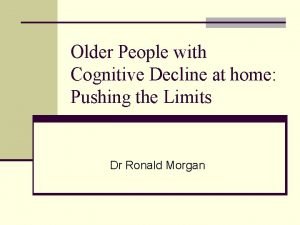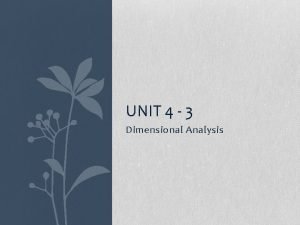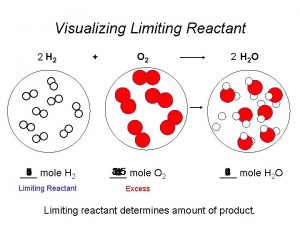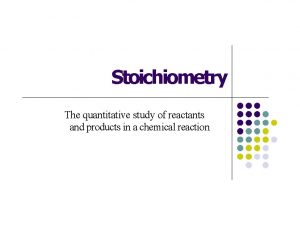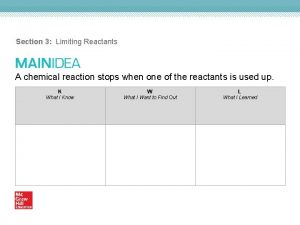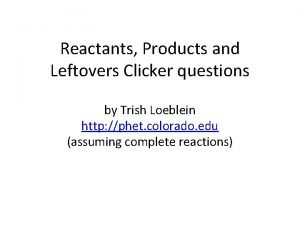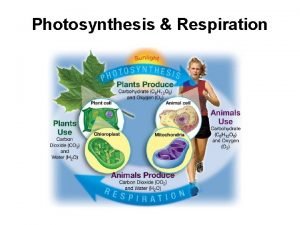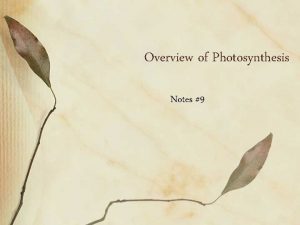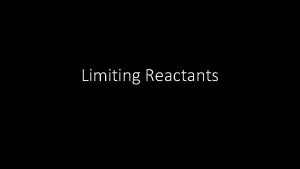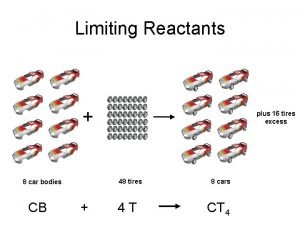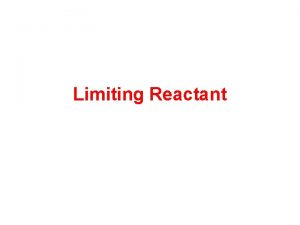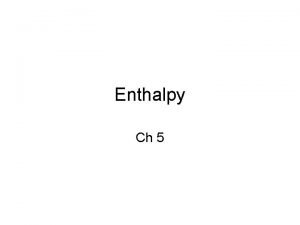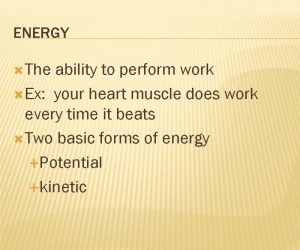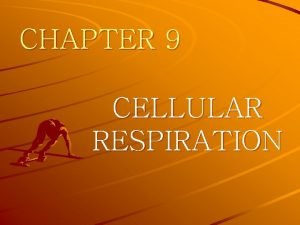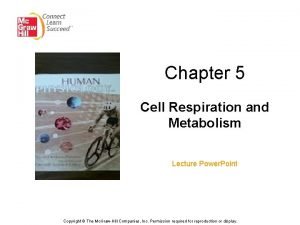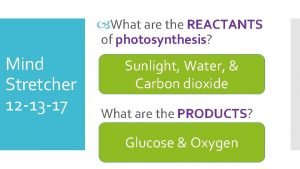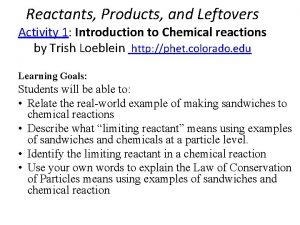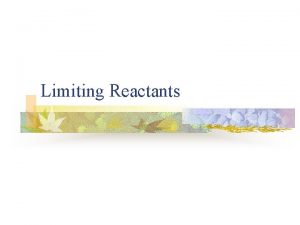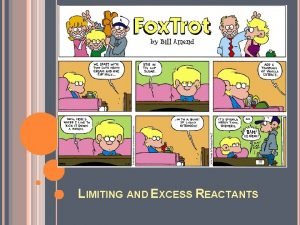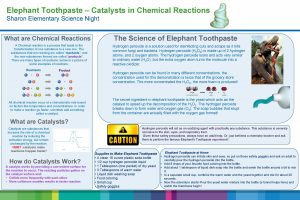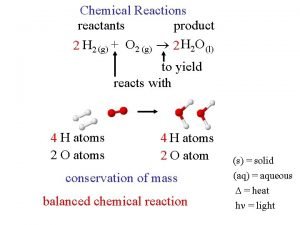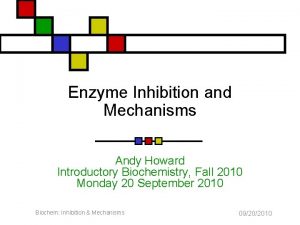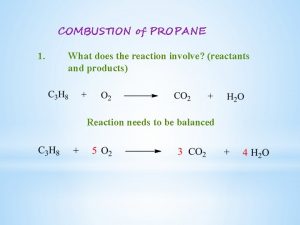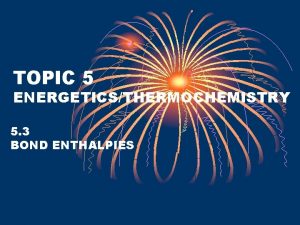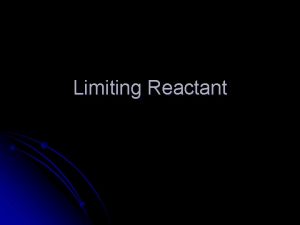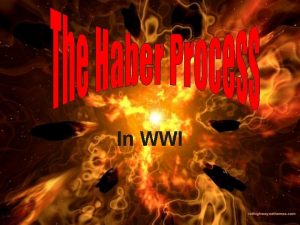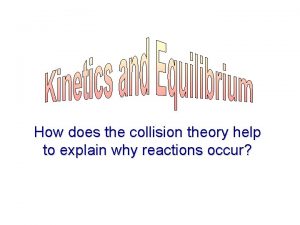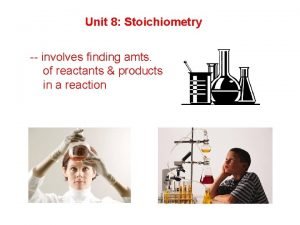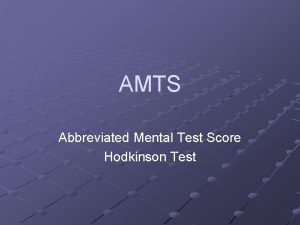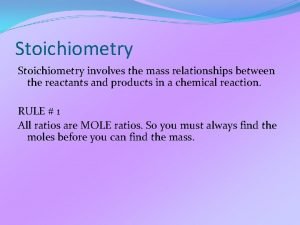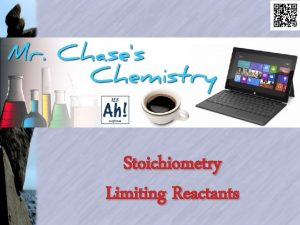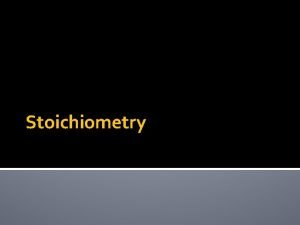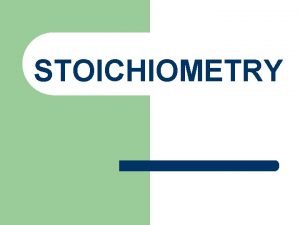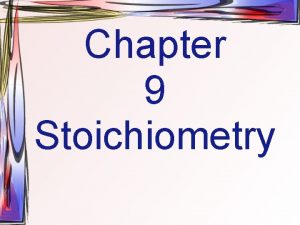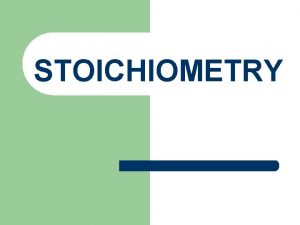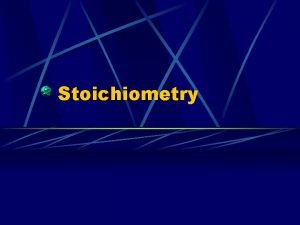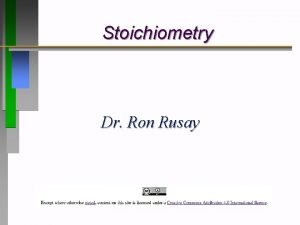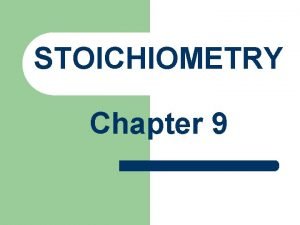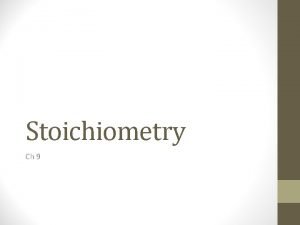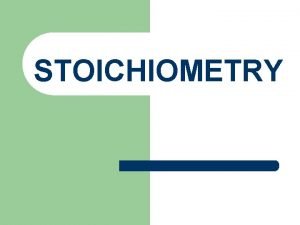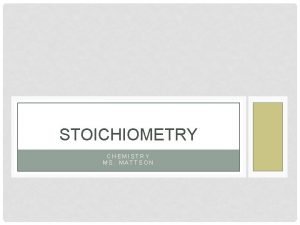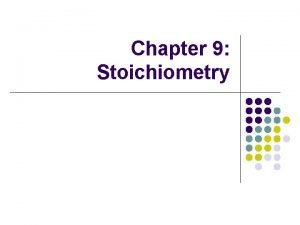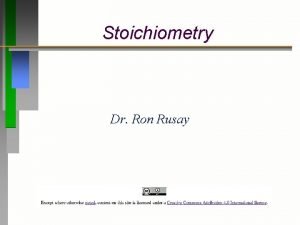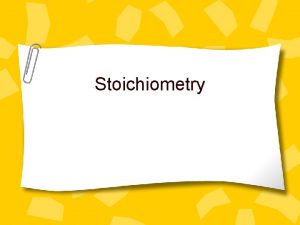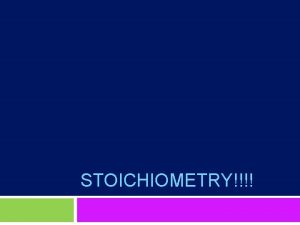Unit 8 Stoichiometry involves finding amts of reactants




































- Slides: 36

Unit 8: Stoichiometry -- involves finding amts. of reactants & products in a reaction

What can we do with stoichiometry? For generic equation: Given the… amount of RA (or RB) amount of RA or RB amount of P 1 or P 2 you need to produce R A + R B P 1 + P 2 …one can find the… amount of RB (or RA) that is needed to react with it amount of P 1 or P 2 that will be produced amount of RA and/or RB you must use

Governing Equation: 2 patties + 3 bread 4 patties + ? 6 bread excess ? 50 patties + 18 bread + ? 75 bread 1 Big Mac® ? 6 Big Macs® 25 Big Macs®

Stoichiometry Island Diagram SUBSTANCE “A” Mass (g) 1 mol = molar mass (in g) 1 mol = 22. 4 L Volume 3 (L or dm ) 1 mol = 22. 4 dm 3 Particle (at. or m’c) SUBSTANCE “B” 1 mol = molar mass (in Use coefficients Mass g) from balanced (g) equation MOLE (mol) 1 mol = 6. 02 x 1023 particles MOLE (mol) 1 mol = 22. 4 L Volume 3 1 mol = 22. 4 dm 3 (L or dm ) 1 mol = 6. 02 x 1023 particles Particle (at. or m’c)

2 4 2 + __C 3 __Ti. O 2 + __Cl 2 1 2 __Ti. Cl 4 + __CO 2 + __CO How many mol chlorine will react with 4. 55 mol carbon? 4. 55 mol C C Cl 2 ( ) 4 mol Cl 2 3 mol C = 6. 07 mol Cl 2 What mass titanium (IV) oxide will react with 4. 55 mol carbon? C Ti. O 2 ( )( 4. 55 mol C 2 mol Ti. O 2 3 mol C ) 79. 9 g Ti. O 2 1 mol Ti. O 2 = 242 g Ti. O 2

How many molecules titanium (IV) chloride can be made from 115 g titanium (IV) oxide? 1 m ol 1 mol ol m 1 ( ol m 1 1 mol 1 m ol coeff. Ti. O 2 )( 115 g Ti. O 2 1 mol Ti. O 2 79. 9 g Ti. O 2 Ti. Cl 4 )( ) 2 mol Ti. Cl 4 6. 02 x 1023 m’c Ti. Cl 4 2 mol Ti. O 2 1 mol Ti. Cl 4 = 8. 7 x 1023 m’c Ti. Cl 4 Island Diagram helpful reminders: 2. middle conversion factor is only onebeing 3. onbridge the from islands each end of the bridge 1. The Use units coefficients theatequation only when crossing that has appear two different in it. The conversion crossed in the conversion factor foralways that bridge. the middle bridge. Thesubstances other six bridges have factors the other six bridges have the same “ 1 mol” for before a substance’s formula. substance in both the numerator and denominator.

2 Ir + Ni 3 P 2 3 Ni + 2 Ir. P If 5. 33 x 1028 m’cules nickel (II) phosphide react w/excess iridium, what mass iridium (III) phosphide is produced? ( 5. 33 x 1028 m’c Ni 3 P 2 1 mol Ni 3 P 2 6. 02 x 1023 m’c Ni 3 P 2 )( )( 2 mol Ir. P 1 mol Ni 3 P 2 ( )( 1 mol Ni 3 P 2 238. 1 g Ni 3 P 2 Ir. P ) 223. 2 g Ir. P 1 mol Ir. P = 3. 95 x 107 g Ir. P How many grams iridium will react with 465 grams nickel (II) phosphide? 465 g Ni 3 P 2 )( 2 mol Ir 1 mol Ni 3 P 2 = 751 g Ir Ir 192. 2 g Ir 1 mol Ir )

2 Ir + Ni 3 P 2 3 Ni + 2 Ir. P How many moles of nickel are produced if 8. 7 x 1025 atoms of iridium are consumed? 8. 7 x 1025 at. Ir ( 1 mol Ir 6. 02 x 1023 at. Ir )( Ir 3 mol Ni 2 mol Ir = 217 mol Ni iridium (Ir) nickel (Ni) Ni )

What volume hydrogen gas is liberated (at STP) if 50 g zinc react w/excess hydrochloric acid (HCl)? Zn H 2 1 Zn + __ 2 HCl __ 50 g excess 50 g Zn ( 1 mol Zn 65. 4 g Zn )( 1 H 2 + __ 1 Zn. Cl 2 __ XL 1 mol H 2 1 mol Zn )( 22. 4 L H 2 1 mol H 2 = 17. 1 L H 2 )

At STP, how many m’cules oxygen react with 632 dm 3 butane (C 4 H 10)? C 4 H 10 1 C 4 H 10 + __ 2 13 O 2 __ ( 632 dm 3 C 4 H 10 O 2 4 CO 2 + __ 5 H 2 O 8 10 __ )( 1 mol C 4 H 10 22. 4 dm 3 C 4 H 10 )( 13 mol O 2 2 mol C 4 H 10 2 = 1. 10 x 1026 m’c O 2 Suppose the question had been “how many ATOMS of O 2…” 1. 10 x 1026 m’c O 2 ( 2 atoms O 1 m’c O 2 ) ) 6. 02 x 1023 m’c O 21 mol O = 2. 20 x 1026 at. O

Energy and Stoichiometry CH 4(g) + 2 O 2(g) CO 2(g) + 2 H 2 O(g) + 891 k. J A balanced eq. gives the ratios of moles-to-moles AND moles-to-energy. E CH 4 How many k. J of energy are released when 54 g methane are burned? 54 g CH 4 ( 1 mol CH 4 16 g CH 4 )( 891 k. J 1 mol CH 4 ) = 3007 k. J

CH 4(g) + 2 O 2(g) CO 2(g) + 2 H 2 O(g) + 891 k. J At STP, what volume oxygen is consumed in producing 5430 k. J of energy? 5430 k. J ( 2 mol O 2 891 k. J )( 22. 4 L O 2 1 mol O 2 ) What mass of water is made if 10, 540 k. J are released? 10, 540 k. J ( 2 mol H 2 O 891 k. J )( 18 g H 2 O 1 mol H 2 O E = 273 L O 2 E ) O 2 H 2 O = 426 g H 2 O

The Limiting Reactant A balanced equation for making a Big Mac® might be: 3 B + 2 M + EE With… 30 M 30 B 30 M B 3 M 2 EE …and… excess B and excess EE excess M and excess EE 30 B and excess EE …one can make… 15 B 3 M 2 EE 10 B 3 M 2 EE

A balanced equation for making a tricycle might be: 3 W+2 P+S+H+F W 3 P 2 SHF With… …and… …one can make… 50 P excess of all other reactants 25 W 3 P 2 SHF 50 S excess of all other reactants 50 W 3 P 2 SHF 50 P 50 S + excess of all other reactants 25 W 3 P 2 SHF

Solid aluminum reacts w/chlorine gas to yield solid aluminum chloride. 2 Al(s) + 3 Cl 2(g) 2 Al. Cl 3(s) If 125 g aluminum react w/excess chlorine, how many g aluminum chloride are made? ( 125 g Al 1 mol Al 27 g Al )( )( 2 mol Al. Cl 3 2 mol Al Al Al. Cl 3 133. 5 g Al. Cl 3 1 mol Al. Cl 3 ) = 618 g Al. Cl 3 If 125 g chlorine react w/excess aluminum, how many g aluminum chloride are made? Cl 2 Al. Cl 3 2 mol Al. Cl 3 133. 5 g Al. Cl 3 125 g Cl 2 1 mol Cl 2 71 g Cl 2 1 mol Al. Cl 3 3 mol Cl 2 ( )( )( ) = 157 g Al. Cl 3

2 Al(s) + 3 Cl 2(g) 2 Al. Cl 3(s) If 125 g aluminum react w/125 g chlorine, how many g aluminum chloride are made? 157 g Al. Cl 3 (We’re out of Cl 2. ) limiting reactant (LR): the reactant that runs out first -- amount of product is based on LR Any reactant you don’t run out of is an excess reactant (ER). In a root beer float, the LR is usually the ice cream. (What’s the product? ) Your enjoyment!

With… 30 M 50 P 125 g Al …and… …one can make… 30 B and excess EE 50 S + excess of all other reactants 25 W 3 P 2 SHF 125 g Cl 2 157 g Al. Cl 3 From Examples Limiting Reactant Above… 10 B 3 M 2 EE Excess Reactant(s) Big Macs B M, EE tricycles P W, S, H, F Al / Cl 2 / Al. Cl 3 Cl 2 Al

How to Find the Limiting Reactant For the generic reaction R A + RB P, assume that the amounts of RA and RB are given. Should you use RA or RB in your calculations? 1. Calc. # of mol of RA and RB you have. 2. Divide by the respective coefficients in balanced equation. 3. Reactant having the smaller result is the LR.

For the Al / Cl 2 / Al. Cl 3 example: 2 Al(s) + ( ( 3 Cl 2(g) 2 Al. Cl 3(s) ) ) _. . 2 = 2. 31 125 g Al 1 mol Al 27 g Al 125 g Cl 2 1 mol Cl 2 71 g Cl 2 = 4. 63 mol Al (HAVE) . _ = 1. 76 mol Cl 2. 3 = 0. 58 (HAVE) Step #2 Step #1 LR Step #3 “Oh, bee- HAVE !” (And start every calc. with the LR. )

2 Fe(s) + 3 Cl 2(g) 223 g Fe 179 L Cl 2 2 Fe. Cl 3(s) Which is the limiting reactant: Fe or Cl 2? ( ( 223 g Fe 179 L Cl 2 ) ) 1 mol Fe 55. 8 g Fe 1 mol Cl 2 22. 4 L Cl 2 = 4. 0 mol Fe (HAVE) = 8. 0 mol Cl 2 (HAVE) _. . 2 = 2. 0 LR = Fe _. . 3 = 2. 66 How many g Fe. Cl 3 are produced? (“Oh, bee-HAVE!”) ( )( 4. 0 mol Fe 2 mol Fe. Cl 3 2 mol Fe Fe ) 162. 3 g Fe. Cl 3 1 mol Fe. Cl 3 = 649 g Fe. Cl 3

2 H 2(g) + O 2(g) 13 g H 2 2 H 2 O(g) 80 g O 2 Which is LR: H 2 or O 2? ( ( 13 g H 2 1 mol H 2 2 g H 2 80 g O 2 1 mol O 2 32 g O 2 ) ) . 2 = 3. 25 = 6. 5 mol H 2 _. (HAVE). _ = 2. 5 mol O 2. 1 = 2. 50 (HAVE) LR = O 2 How many g H 2 O are formed? (“Oh, bee-HAVE!”) ( 2. 5 mol O 2 )( 2 mol H 2 O 1 mol O 2 18 g H 2 O 1 mol H 2 O ) O 2 H 2 O = 90 g H 2 O

How many g O 2 are left over? zero; O 2 is the LR and therefore is all used up How many g H 2 are left over? We know how much H 2 we started with (i. e. , 13 g). To find how much is left over, we first need to figure out how much was USED UP in the reaction. ( 2. 5 mol O 2 2 mol H 2 1 mol O 2 )( 2 g H 2 1 mol H 2 Started with 13 g, used up 10 g… ) O 2 H 2 = 10 g H 2 used up 3 g H 2 left over

2 Fe(s) + 3 Br 2(g) 181 g Fe 96. 5 L Br 2 2 Fe. Br 3(s) Find LR. ( ( . 2 = 1. 62 = 3. 24 mol Fe _. (HAVE) ) ) 181 g Fe 1 mol Fe 55. 8 g Fe 96. 5 L Br 2 1 mol Br 2 22. 4 L Br 2 _. = 4. 31 mol Br 2. 3 = 1. 44 (HAVE) LR = Br 2 How many g Fe. Br 3 are formed? (“Oh, bee-HAVE!”) ( )( 4. 31 mol Br 2 2 mol Fe. Br 3 3 mol Br 2 ) 295. 5 g Fe. Br 3 1 mol Fe. Br 3 Br 2 Fe. Br 3 = 849 g Fe. Br 3

2 Fe(s) + 3 Br 2(g) 181 g Fe 96. 5 L Br 2 2 Fe. Br 3(s) How many g of the ER are left over? 4. 31 mol Br 2 ( 2 mol Fe 3 mol Br 2 )( ) 55. 8 g Fe 1 mol Fe Started with 181 g, used up 160 g… Br 2 Fe = 160 g Fe used up 21 g Fe left over

Al 3+ O 2– Percent Yield Na 1+ O 2– solid molten solid aluminum sodium aluminum oxide 6 Na(l) + 1 Al 2 O 3(s) 2 Al(l) + 3 Na 2 O(s) Find mass of aluminum produced if you start w/575 g sodium and 357 g aluminum oxide. ( ( 575 g Na 1 mol 23 g 357 g Al 2 O 3 1 mol 102 g ( 3. 5 mol Al 2 O 3 ) ) . 6 = 4. 17 = 25 mol Na _. (HAVE) . _ = 3. 5 mol Al 2 O 3. 1 = 3. 5 2 mol Al 1 mol Al 2 O 3 (HAVE) )( 27 g Al 1 mol Al ) Al 2 O 3 LR Al = 189 g Al

189 g This amt. of product (______) is theoretical yield. -- amt. we get if reaction is perfect -- found by calculation Now suppose that we perform this reaction and get only 172 grams of aluminum. Why? -- couldn’t collect all Al -- not all Na and Al 2 O 3 reacted -- some reactant or product spilled and was lost

-- % yield can never be > 100%. Find % yield for previous problem. = 91. 0%

Reaction that powers space shuttle is: 2 H 2(g) + O 2(g) 2 H 2 O(g) + 572 k. J From 100 g hydrogen and 640 g oxygen, what amount of energy is possible? ( ( 100 g H 2 1 mol H 2 2 g H 2 640 g O 2 1 mol O 2 32 g O 2 ) ) . _ = 50 mol H 2. 2 = 25 (HAVE) _. = 20 mol O 2. 1 = 20 (HAVE) LR O 2 E 20 mol O 2 ( 572 k. J 1 mol O 2 ) = 11, 440 k. J

2 H 2(g) + O 2(g) 2 H 2 O(g) + 572 k. J What mass of excess reactant is left over? ( 20 mol O 2 2 mol H 2 1 mol O 2 )( 2 g H 2 1 mol H 2 Started with 100 g, used up 80 g… ) O 2 H 2 = 80 g H 2 used up 20 g H 2 left over

On NASA spacecraft, lithium hydroxide “scrubbers” remove toxic CO 2 from cabin. CO 2(g) + 2 Li. OH(s) Li 2 CO 3(s) + H 2 O(l) For a seven-day mission, each of four individuals exhales 880 g CO 2 daily. If reaction is 75% efficient, how many g Li. OH should be brought along? ( 880 g CO 2 person-day ( ) x (4 p) x (7 d) = 24, 640 g CO 2 )( 24, 640 g CO 2 1 mol CO 2 44 g CO 2 = 26, 768 g Li. OH )( 2 mol Li. OH 1 mol CO 2 (Need (if reaction more. 0. 75) isthan perfect) this!) ( _. CO 2 Li. OH 23. 9 g Li. OH 1 mol Li. OH ) = 35, 700 g Li. OH REALITY: TAKE 100, 000 g

Automobile air bags inflate with nitrogen via the decomposition of sodium azide: 2 Na. N 3(s) 3 N 2(g) + 2 Na(s) At STP and a % yield of 85%, what mass sodium azide is needed to yield 74 L nitrogen? Shoot for… 74. L = 87. 1 L N 2 _ (. 0. 85) ( 87. 1 L N 2 1 mol N 2 22. 4 L N 2 )( )( 2 mol Na. N 3 3 mol N 2 ) 65 g Na. N 3 1 mol Na. N 3 = 169 g Na. N 3 Conceptual question (How would you do it? ) __C 3 H 8 + __O 2 Xg Yg Strategy: __CO 2 + __H 2 O + __k. J ? k. J 1. Find LR. 2. Calc. ? k. J. LR E

B 2 H 6 + 3 O 2 10 g 30 g 10 g B 2 H 6 30 g O 2 ( ( ( 1 mol 27. 6 g 1 mol 32 g B 2 O 3 + 3 H 2 O Xg . 1 = 0. 362 mol B 2 H 6 _. (HAVE) ) ) . _ = 0. 938 mol O 2. 3 = 0. 313 (HAVE) )( 0. 938 mol O 2 1 mol B 2 O 3 3 mol O 2 69. 6 g B 2 O 3 1 mol B 2 O 3 ) O 2 LR B 2 O 3 = 21. 8 g B 2 O 3

2 3 2 ___Zn. S + ___O 100 g 2 2 ___Zn. O + ___SO 2 100 g X g (assuming 81% yield) 1. Balance and find LR. 2. Use LR to calc. X g Zn. O (theo. yield) 3. Actual yield is 81% of theo. yield. Strategy: ( ( 100 g Zn. S 100 g O 2 1. 026 mol Zn. S 1 mol 97. 5 g 1 mol 32 g ( ) ) . 2 = 0. 513 = 1. 026 mol Zn. S _. (HAVE) LR . _ = 3. 125 mol O 2. 3 = 1. 042 (HAVE) )( 2 mol Zn. O 2 mol Zn. S 81. 4 g Zn. O 1 mol Zn. O ) Zn. O = 83. 5 g Zn. O Actual g Zn. O = 83. 5 (0. 81) = 68 g Zn. O

2 1 ___Al + ___Fe 2 O 3 Xg Xg Shoot for… 2 1 ___Fe + ___Al 2 O 3 800 g needed **Rxn. has an 80% yield. 800 g Fe = 1000 g Fe. _ (. 0. 80) Fe ( 1000 g Fe )( 1 mol Fe 55. 8 g Fe 2 mol Al 2 mol Fe )( )( 27 g Al 1 mol Al Fe Al ) = 484 g Al Fe 2 O 3 ) 1 mol Fe 2 O 3 159. 6 g Fe 2 O 3 = 1430 g 1 mol Fe 2 O 3 2 mol Fe Fe 2 O 3


0 0
 Amts score
Amts score Solving a problem involves finding missing
Solving a problem involves finding missing Unit: stoichiometry “multi-step problems” – ws #3
Unit: stoichiometry “multi-step problems” – ws #3 Unit 6 review questions
Unit 6 review questions Limiting reagent problems
Limiting reagent problems Stoichiometry is defined as the quantitative study of
Stoichiometry is defined as the quantitative study of What is used up in and stops a chemical reaction
What is used up in and stops a chemical reaction Phet products reactants and leftovers
Phet products reactants and leftovers Reactant products and leftovers
Reactant products and leftovers Amloplast
Amloplast Reactants of calvin cycle
Reactants of calvin cycle Photosynthesis reactants/inputs
Photosynthesis reactants/inputs Limiting ingredient
Limiting ingredient Theoretical yield def
Theoretical yield def Limiting and excess reactants race car answers
Limiting and excess reactants race car answers Limiting reactants practice worksheet
Limiting reactants practice worksheet Reactants of photosynthesis
Reactants of photosynthesis Reactants - products enthalpy
Reactants - products enthalpy Glycolysis reactants
Glycolysis reactants Reactants and products
Reactants and products Synthesis and combustion reaction
Synthesis and combustion reaction What are the reactants and products of photosynthesis?
What are the reactants and products of photosynthesis? Glycolysis reactants
Glycolysis reactants Reactants of photosynthesis
Reactants of photosynthesis Reactants
Reactants Limiting reactant definition
Limiting reactant definition Excess reactant calculation
Excess reactant calculation Elephant toothpaste reactants and products
Elephant toothpaste reactants and products Hydrogen chloride
Hydrogen chloride Reactants and products
Reactants and products Reactants enzyme
Reactants enzyme What bonds are broken in the combustion of propane
What bonds are broken in the combustion of propane Bond enthalpy reactants minus products
Bond enthalpy reactants minus products How to identify limiting reactant
How to identify limiting reactant How to find limiting reagents
How to find limiting reagents Reactants
Reactants Reactant and product
Reactant and product
